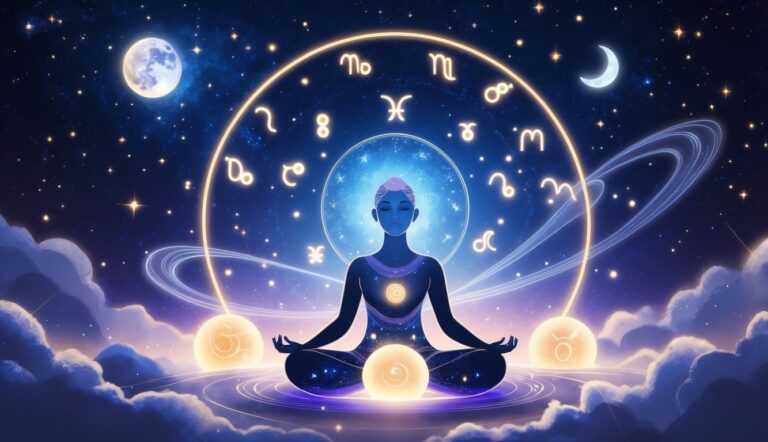Align Your Life with Your True North
The Power Quadrant System decodes your natural talents and pinpoints the career, timing and relationships that let you earn more, love deeper, and wake up eager for the day.
- Uncover your #1 high-income strength
- Draw in partners who raise your energy
- Work when your body’s clock is in “flow”
Indigenous cultures around the world have developed rich spiritual practices over thousands of years.
These traditions offer profound wisdom that can deepen your connection to nature, community, and the sacred.
By exploring diverse indigenous spiritual practices, you may discover new perspectives and meaningful rituals to incorporate into your own life.
Learning about indigenous spiritual practices can expand your worldview and provide inspiration for your personal growth journey. Many of these ancient traditions emphasize harmony with the natural world, respect for ancestors, and holistic approaches to healing and wellbeing.
As you explore these practices, remember to approach them with respect and an open mind.
Consider how elements of indigenous spirituality might complement your existing beliefs or practices in a way that feels authentic to you.
1) Ayahuasca rituals
Ayahuasca rituals have been a significant part of indigenous cultures in the Upper Amazon for centuries.
Indigenous shamans guide participants through the experience.
These rituals use a sacred brew made from the ayahuasca vine and leaves of certain plants.
People often take part in them to gain knowledge, enter enhanced states of consciousness, and facilitate healing.
The practice has deep cultural roots.
Decode Your Personal Success Blueprint
Power Quadrant System shows you the exact career, relationships, and daily rhythm that match your natural DNA—so you earn more, work happier, and connect deeper.
- Pinpoint your #1 money-making talent
- Erase conflict & attract ideal partners
- Multiply productivity with perfect timing
It’s important to note that ayahuasca rituals were developed within specific cultural contexts for Indigenous peoples.
This spiritual grounding is crucial to the authentic experience.
In recent years, ayahuasca tourism has become popular.
However, this trend sometimes overlooks the traditional Indigenous practices and spiritual foundations of the ritual.
If you’re interested in ayahuasca, remember that it’s more than just a psychoactive substance.
It’s a powerful tool for spiritual and psychological growth when used in its proper cultural context.
The effects can be intense and transformative.
You might experience vivid visions, emotional insights, and a sense of connection to nature and the universe.
Always approach ayahuasca with respect for its cultural significance.
Tap Into Your Built-In Success GPS
The Power Quadrant System deciphers your genetic blueprint so you can lock onto the career, income and relationships that feel effortless—and wildly rewarding.
- Zero in on your natural high-earning genius
- Sync with partners who boost your vibe
- Wake up driven, finish days fulfilled
2) Sweat lodge ceremonies
Sweat lodge ceremonies are powerful spiritual practices deeply rooted in Native American traditions.
These sacred rituals take place in dome-shaped structures, often made of natural materials like willow branches and animal hides.
As you enter the lodge, you’ll find hot stones placed in the center.
Water is poured over these stones, creating steam and intense heat.
This environment promotes physical and spiritual cleansing.
The ceremony typically involves prayer, singing, and sharing of wisdom.
You might hear the beating of drums or the shaking of rattles, adding to the spiritual atmosphere.
Participating in a sweat lodge can help you connect with nature, honor ancestors, and seek guidance from the spiritual realm.
It’s a time for reflection, healing, and personal growth.
These ceremonies also foster a sense of community.
You’ll likely share the experience with others, creating bonds and strengthening relationships.
Remember, sweat lodges are sacred spaces.
If you’re invited to participate, approach the experience with respect and an open mind.
It’s a unique opportunity to engage with an ancient spiritual practice and gain insights into Native American culture.
3) Dreamtime storytelling
Dreamtime storytelling is a cornerstone of Indigenous Australian spirituality and culture.
These ancient narratives form the foundation of Aboriginal beliefs, connecting people to their land and ancestors.
You’ll find Dreamtime stories woven into every aspect of Aboriginal life.
They explain the creation of the world, natural phenomena, and moral codes that guide communities.
As you explore this practice, you’ll discover its role in preserving cultural identity.
Elders pass down these oral traditions to younger generations, ensuring the continuity of knowledge and values.
Dreamtime stories often feature shape-shifting ancestors who molded the landscape.
You might hear tales of giant serpents carving out rivers or celestial beings creating mountains and valleys.
When you listen to these stories, you’re not just hearing entertainment.
You’re experiencing a sacred link to the past and gaining insight into Aboriginal worldviews.
Dreamtime storytelling goes beyond words.
It’s often accompanied by art, dance, and music, creating a multi-sensory spiritual experience.
By engaging with Dreamtime stories, you can gain a deeper appreciation for Aboriginal culture and its profound connection to the natural world.
4) Inipi purification ritual
The Inipi, or sweat lodge ceremony, is a sacred purification ritual practiced by the Lakota people.
The ceremony aims to cleanse your body, mind, and spirit.
During the Inipi, you’ll participate in prayer, singing, and meditation.
The ritual often involves four rounds, each representing different aspects of life and the natural world.
The Inipi is more than just physical cleansing.
It’s a spiritual rebirth that helps you connect with yourself, your community, and the universe.
You might find this ceremony challenging, but many participants report feeling renewed and enlightened afterward.
The Inipi is believed to promote healing, clarity, and a deeper understanding of life’s mysteries.
Remember, this is a sacred practice deeply rooted in Lakota culture.
If you’re invited to participate, approach it with respect and an open mind.
5) Sun Dance ceremony
The Sun Dance is a sacred ritual practiced by various Native American tribes, particularly those of the Plains cultures.
This powerful ceremony holds deep spiritual significance for indigenous communities.
The Sun Dance typically occurs annually, often during the summer months.
It serves as a time of renewal, healing, and connection to the Great Spirit.
During the ceremony, participants gather to dance, pray, and fast.
The central focus is often a tree, symbolizing the connection between earth and sky.
Dancers move around this tree, sometimes tethered to it by cords attached to piercings in their skin.
The Sun Dance can last for several days, with dancers abstaining from food and water.
This act of self-sacrifice is seen as a way to honor the spirits and seek blessings for the community.
You’ll find that the Sun Dance plays a crucial role in maintaining cultural identity and strengthening community bonds.
It’s a time when otherwise independent bands come together to reaffirm their beliefs and traditions.
While specific practices may vary among tribes, the core elements of gratitude, sacrifice, and spiritual connection remain consistent.
The Sun Dance continues to be a vital part of Native American spirituality today.
6) Cacao ceremonies
Cacao ceremonies are ancient spiritual practices rooted in Mesoamerican cultures.
These rituals use ceremonial-grade cacao, often prepared as a warm beverage, to facilitate deep connections with oneself and the divine.
Indigenous peoples like the Maya and Aztecs revered cacao for its physical, mental, and spiritual benefits.
They believed it could open the heart and promote healing.
In modern cacao ceremonies, participants gather to drink the sacred beverage and set intentions.
The cacao is thought to enhance meditation, foster emotional release, and promote inner reflection.
These ceremonies often incorporate breathwork, music, and guided meditation to deepen the experience.
While cacao is the focus, some enthusiasts also explore awesome coffee hacks to enhance their daily rituals and mindfulness practices.
By creating a sacred space and savoring each sip, participants cultivate a deeper connection to themselves and their surroundings.
You might experience a sense of grounding and heightened awareness during a ceremony.
The natural compounds in cacao can create mild euphoria and increased focus.
These ceremonies honor the plant’s spiritual significance while creating a space for personal growth and community bonding.
As you partake in this tradition, you connect with ancient wisdom and your own inner truth.
Cacao ceremonies offer a unique way to explore spirituality and self-discovery.
They provide a gentle, heart-centered approach to introspection and healing.
7) Vision quest practices
Vision quests are powerful spiritual journeys practiced by many indigenous cultures, particularly Native American tribes.
These rituals serve as rites of passage, helping individuals seek guidance and wisdom from the spiritual realm.
To embark on a vision quest, you typically venture into nature alone for several days.
You fast and meditate in isolation, opening yourself to receive visions or messages from the spirit world.
During this time, you might engage in prayer, sing sacred songs, or perform rituals specific to your tribe’s traditions.
The goal is to connect deeply with the natural world and your inner self.
Vision quests often mark important life transitions, such as the passage from adolescence to adulthood.
They can also be undertaken to seek answers to personal questions or gain spiritual insight.
While practices vary among different indigenous groups, the core purpose remains the same: to foster personal growth and spiritual awakening through a profound connection with nature and the spirit realm.
Today, some indigenous communities continue to practice traditional vision quests, preserving this ancient spiritual custom for future generations.
8) Peyote ceremonies
Peyote ceremonies are sacred rituals practiced by some Native American tribes, particularly in the southwestern United States.
These ceremonies involve the use of peyote, a small cactus containing psychoactive compounds.
The rituals typically last all night, often starting on Saturday evening and ending Sunday morning.
During this time, participants gather in a circle and engage in prayer, singing, and drumming.
Consuming peyote is considered a sacrament within these ceremonies.
It’s believed to facilitate a connection with the spiritual realm and promote healing.
Many participants report profound spiritual experiences and insights during these rituals.
The Native American Church has incorporated peyote use into its religious practices.
For its members, these ceremonies are an essential part of their spiritual tradition.
It’s important to note that peyote use in this context is strictly ceremonial and deeply rooted in Native American spirituality.
These rituals foster a sense of community and help maintain cultural traditions.
Understanding Indigenous Spiritual Practices
Indigenous spiritual practices are deeply rooted in tradition and offer profound insights into the human experience.
These practices emphasize harmony with nature and the interconnectedness of all living things.
Cultural Significance
Many communities consider indigenous spiritual practices as the cornerstone of their cultural identity.
These practices often involve rituals, ceremonies, and storytelling passed down through generations.
They help preserve ancient wisdom and strengthen community bonds.
You’ll find that many indigenous cultures view spirituality as inseparable from daily life.
It’s not just about belief, but a way of living in balance with the world around you.
For example, smudging is a common practice that involves burning sacred herbs to purify spaces and individuals.
It’s a ritual that connects you to your ancestors and cleanses negative energy.
Connection to Nature
Indigenous spiritual practices also emphasize a deep connection to the natural world.
They encourage you to view yourself as part of nature, not separate from it.
Many rituals take place outdoors, allowing you to directly engage with the elements.
Sun Dance ceremonies, for instance, involve days of prayer and fasting in harmony with the rhythms of the sun.
You might find that these practices teach respect for all living things.
Animals, plants, and even rocks are often seen as having spirits and deserving of reverence.
By embracing these nature-based spiritual practices, you can gain a new perspective on your place in the world and your responsibility to care for the environment.
Respecting Indigenous Traditions
Honoring and respecting indigenous spiritual practices requires mindfulness and sensitivity.
It’s crucial to approach these traditions with genuine interest and a willingness to learn, while being aware of potential cultural misappropriation.
Authenticity and Misappropriation
When exploring indigenous spiritual practices, remember to avoid cultural appropriation.
Be cautious about adopting sacred rituals or symbols without proper understanding or permission.
Instead, focus on learning about the cultural context and significance behind these practices.
If you’re interested in participating, seek guidance from respected community members or elders.
Be wary of commercialized versions of indigenous spirituality.
Many “New Age” interpretations can misrepresent or oversimplify complex traditions.
Remember, indigenous spirituality is often deeply tied to specific lands, languages, and communities.
It’s not something that can be easily separated from its cultural roots.
Learning from Elders
Elders play a vital role in preserving and passing down indigenous spiritual knowledge.
If you wish to learn more, seek out opportunities to listen to and learn from indigenous elders.
Attend cultural events or workshops led by indigenous community members.
These can provide valuable insights into spiritual practices and their significance.
When you interact with elders, show respect by listening more than speaking.
Also, be patient and open to different ways of sharing knowledge.
Remember that not all information is meant to be shared publicly.
Some teachings may be reserved for community members or those who have earned the right to receive them.
By approaching indigenous spiritual traditions with respect and humility, you can gain meaningful insights while honoring the cultures they come from.










